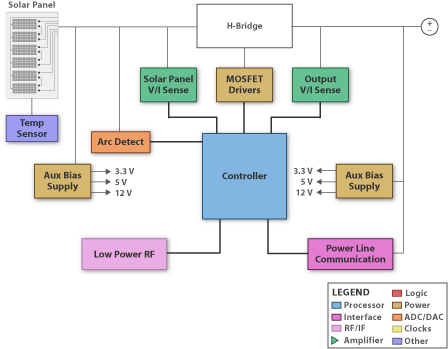
Design Considerations
Photovoltaic (PV) installations tied to the grid are usually built with arrays of modules connected in series to string inverters. An emerging system architecture to harvest more energy per module by supplementing the conventional string inverter uses dc-dc converters dedicated to individual modules. These systems, known as microconverters or dc-dc power optimizers address partial shading and other aging issues by implementing maximum power point tracking (MPPT) at the individual module level so that underperforming modules do not constrain the entire string.
At the heart of the inverter is an MPPT algorithm which can be implemented through a microcontroller or an MPPT controller. The controller executes the very precise algorithms required to keep the panel at the maximum power extraction point while adjusting the dc-dc conversion to produce the output dc voltage required for the string. This controller is programmed to perform the control loops necessary for all the power management functions. The PV maximum output power is dependent on the operating conditions and varies from moment to moment due to temperature, shading, soilage, cloud cover, and time of day so tracking and adjusting for this maximum power point is a continuous process. The controller contains advanced peripherals like high precision PWM outputs and ADCs for implementing control loops. The ADC measures variables, such as the PV output voltage and current, and then adjusts the DC/DC converter by changing the PWM duty cycle depending on the load. Complex schemes exist to track the true maximum even in partially-shaded PV modules.
Real time processors designed to read the ADC and adjust the PWM within a single clock cycle are desirable. Communications on a simple system can be handled by a single processor, more elaborate systems with complex reporting on monitoring may require a secondary processor. Current sensing is done through flux-gate sensors or shunt resistors. For safety reasons, isolation between the processor and the current and voltage may be required, as well as on the communications bus to the outside world. Delta-Sigma Modulators which include integrated isolation are desirable. The bias supply uses DC-DC converters to provide power to the electronics on the inverter. MOSFET/IGBT drivers which can handle the higher voltages and include integrated sensing are also desired. Sometimes, communications capability is included so users can monitor the converter, report on power and operating conditions and provide firmware updates. Typically Power Line Communication (PLC) to reduce wiring or wireless (Bluetooth, ZigBee/IEEE802.15.4, 6loWPAN) networking options are used.
Download Full Block Diagram Below
Advertisement

Learn more about Texas Instruments





